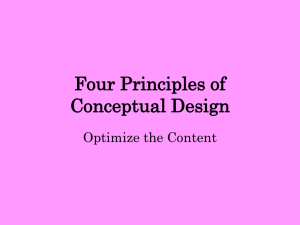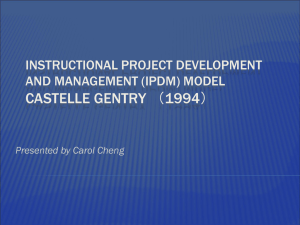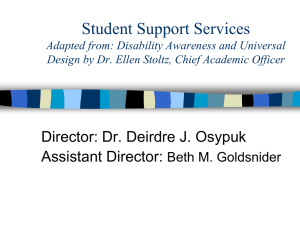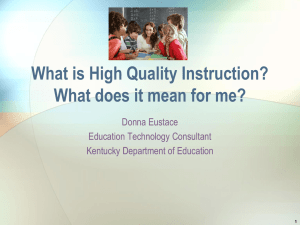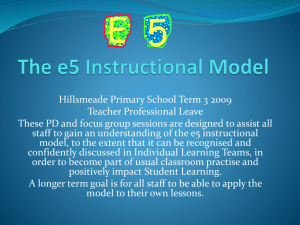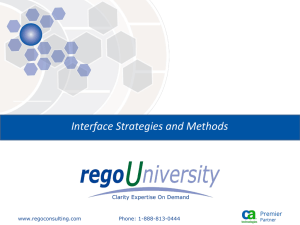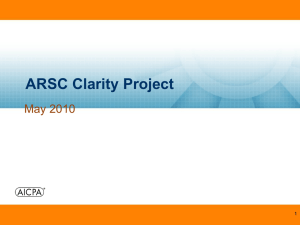Student Achievement
advertisement
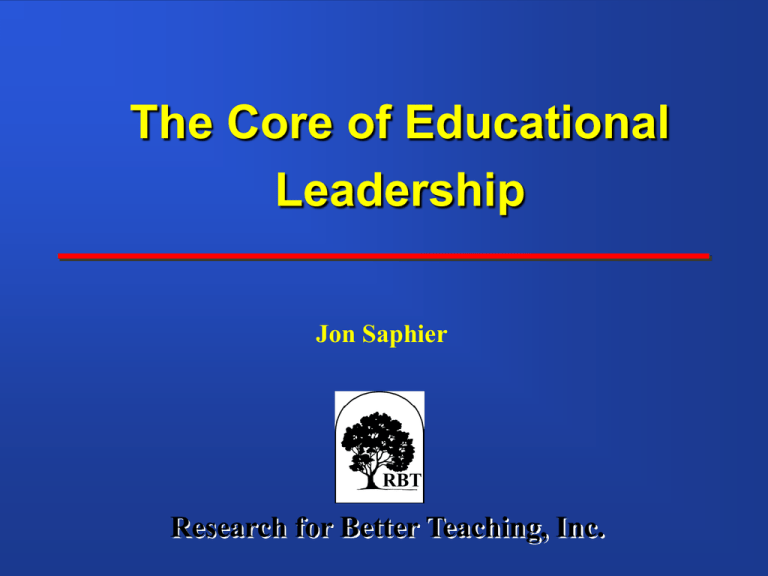
The Core of Educational Leadership Jon Saphier RBT Research for Better Teaching, Inc. Accomplished educators are always asking: “How can we get better?” Four Historical Approaches to Improving Student Achievement 2. 90s: Change Structures and Schedules 1. 1980s: Curriculum Packages and Programs 4. 2000s: Use Data 3. 90’s & 2000s Standards and Accountability 5. Focus on High-Expertise Teaching What is the most significant variable in increasing student achievement? What Teachers Know, Believe & Can Do Increased Student Achievement FIFTH GRADE MATH SCORES ON TENNESSEE STATEWIDE TEST BASED ON TEACHER SEQUENCE IN GRADES 3, 4, 5 (Second Grade Scores Equalized) Research by Sanders & Rivers (1996) 96 100 T e 80 s P t e r S c c e 60 o n r t e i s l e 40 b y 79 44 20 0 Students with 3 Least Effective Teachers Students with 3 Average Effective Teachers Students with 3 Most Effective Teachers M.E.T. (Gates Project) 2012 Research The variation in teaching effectiveness between classrooms within a school is greater than the variation in effectiveness between schools. [Thus student learning hinges on the expertise of the teacher in front of them now!] Outcomes of Day 1. Dive into the nature of teaching expertise….Goal: common images, common language and concept system for talking about teaching togther 2. Insights into how leaders at both building and central levels can most influence classroom teaching expertise. 7 Propositions about Teaching Proposition 1: Teachers are preeminently important. Proposition 2: There is a real knowledge base about teaching that is practical, accessible, huge, complex, and validated…and it’s different. Definition “Teaching skill” is anything a person does that influences the probability of intended learning. Anything! Personal relationships…Teamwork skills…Data analysis skills…Error analysis skills…Family inclusion skills… • Proposition 3: We need a common language and concept system for holding this knowledge and talking about it together. • Proposition 4: The nature of professional knowledge in any field is: --Tasks to be accomplished --Repertoire of ways to accomplish them --Skill at matching the response or strategy one picks from one’s repertoire to match the content, the people, or the situation • Proposition 5: For all our students…we want more good teaching in more classrooms for more children more of the time …not a blame statement. • Proposition 6: The school-as-workplace is the prime site for teacher learning. • Proposition 7: Leaders make the difference on whether the school becomes a dynamic and powerful site for teacher learning…for improving classroom teaching and learning. • “Where to Show Up and What to Do” • So the core of educational leadership is: mobilizing collective action to improve teaching expertise in every classroom. KEY CONCEPTS • Tasks • Repertoire • Matching Overarching Objectives Curriculum Design Planning Assessment CURRICULUM Objectives Learning Experiences Personal Relationship Building Class Climate MOTIVATION Expectations/Effort Based Ability Clarity Space Principles of Learning Time Models of Teaching INSTRUCTIONAL STRATEGIES Routines MANAGEMENT Attention Momentum Discipline FOUNDATION OF ESSENTIAL BELIEFS Punish Exclude Threaten Sharp Sarcasm Judgmental Reprimand Order Specific Verbal Desist General Verbal Desist Mild Sarcasm Private Desist Bringing in Group Pressure Peer Competition Move Seat “I” Message Remove Distraction Offer Choice Urge Remind Flattery Signals Pause and Look Name Dropping Offer Help Touch Proximity DESISTING Startle Using Student ’s Name in Instructional Example Redirecting Partial Answer Pre-Alert Unison Looking at One, Talking to Another Incomplete Sentences ALERTIING Equal Opportunity Random Order Circulation Wait-Time Eye Contact Freedom from Distraction (visual and auditory) The Attention Continuum Voice Variety Gesture Piquing Student ’s Curiosity Suspense Challenge ENLISTING Making Student a Helper Props Personification Connecting with Student ’s Fantasies Acknowledging Encouragement Enthusiasm Praise Humor Dramatizing ACKNOWLEDGING WINNING 5 Least Done Attn. Moves • • • • • “I” Message Pre-Alert Wait-Time Props Dramatizing KEY CONCEPTS • Areas of Performance • Repertoire • Matching Overarching Objectives Curriculum Design Planning Assessment CURRICULUM Objectives Learning Experiences Personal Class Climate Relationship Building Expectations/Effort-Based Ability Clarity Space Principles of Learning Time Models of Teaching MOTIVATION INSTRUCTIONAL STRATEGIES Routines MANAGEMENT Attention Momentum Discipline FOUNDATION OF ESSENTIAL BELIEFS 3 KEY MESSAGES 1. What we’re doing is important. 2. You can do it. 3. I won’t give up on you, even if you give up on yourself. 1:46 TEACHER CHOICE OF LANGUAGE IN RECURRING SPECIFIC SITUATIONS: • • • • • • • • Patterns of calling on students Responses to student answers Giving help Dealing with errors Giving tasks and assignments Feedback on individual student performance, including authentic praise Being tenacious Framing re-teaching events THE BOTTOM LINE OF EFFORT BASED ABILITY • Our work as educators, in fact a major part for some kids, is : 1) Convincing them they can grow their ability at academics. 2) Showing them how. 3) Motivating them to want to. 5 BELIEFS THAT LIBERATE OR LIMIT LEARNING LIFE LIBERATING BELIEFS Mistakes help one learn LIFE LIMITING BELIEFS vs. You are not supposed to understand everything the first vs. time around. Care, perseverance, and craftmanship are what count. Good Students solicit help and lots of feedback on their work. Consistent effort and effective strategies are the main determinants of success Every one is capable of high achievement, not just the fastest and most confident. Mistakes are a sign of weakness Speed is what counts. Faster is smarter. vs. Good students can do it by themselves. vs. Inborn intelligence is the main determinant of success vs. Only the few bright can achieve at a high level. CLARITY 1. Framing the Big Picture • Objectives • Itinerary • Big Idea/Essential Question • Reason for Activity • Reason it’s Worthwhile • Criteria for Success CLARITY 2. Getting Ready for Instruction • Anticipate Confusions • Pre-assessing • Activating Students’ Current Knowledge fo x g n f ly i es ra b h unt 36" d ay ec lo o h io t a c ba e agle s p s le e Au s b it n na na s Fru it Bat s Fruit Bats t ra li m o nit plu m a l r o s Ea s t r a z i d In d i e s ni g c h ic k en ht c ro c o dile s s pit Dividends of “Wordsplash” • • • • • • • • • Student know things to look for Calls for predicting Summons prior knowledge Make connections Adjust …active reader Motivating Ownership Interactive Pressure off – safe CLARITY 3. Presenting Information….. --Twelve Explanatory Devices 4. Speech 5. Explicitness 6. Making Cognitive Connections Explanatory Devices …especially powerful are • • • • Modeling Thinking Aloud Visual Imagery Models Diagrams and visual presentations CLARITY Getting Inside Students’ Heads 7. Checking for Understanding 8. Unscrambling Confusions 9. Creating interactive dialog to Make Students’ Thinking Visible CLARITY V. CONSOLIDATING AND ANCHORING THE LEARNING 10. Summarizing Getting students cognitively active in summarizing 30 Summarizing Structures • • • • • • • • • • • • • • • 10-2 Learning Buddies 3…2…1… The Important Thing… Luck of the Draw Paired Verbal Fluency “Summary Sam” Sorting Cards One Word Summary Synectics Review One Question Quiz A• B • C Summarize Cheat Notes Best Test Relay Summary • • • • • • • • • • • • • • • Write a Rap Ticket to Leave Carousel Brainstorming Graphic Organizers Medium-Size Circle Draw Picture/Diagram Learning Logs Thinking Logs Think – Pair – Share Biopoems Reciprocal Teaching Last Word Board Games The Envelope Please Inside-Outside Circle KEY CONCEPTS • Areas of Performance • Repertoire • Matching Overarching Objectives Curriculum Design Planning Assessment CURRICULUM Objectives Learning Experiences Personal Relationship Building Class Climate MOTIVATION Expectations/Effort Based Ability Clarity Space Principles of Learning Time Models of Teaching INSTRUCTIONAL STRATEGIES Routines MANAGEMENT Attention Momentum Discipline FOUNDATION OF ESSENTIAL BELIEFS FEEDBACK “Academic feedback is more strongly and consistently related to achievement than any other teaching behavior. This relationship is consistent regardless of grade, socioeconomic status, race, or school setting” (Bellon, Bellon, and Blank, 1997, p. 277). FEEDBACK “The most powerful single modification that enhances achievement,” writes Hattie (in Ainsworth and Viegut, 2006, p. 89), “is feedback. The simplest prescription for improving education must be ‘dollops of feedback.’” •0:40 What skills show up in this clip? KEY CONCEPTS • Areas of Performance • Repertoire • Matching Overarching Objectives Curriculum Design Planning Assessment CURRICULUM Objectives Learning Experiences Personal Class Climate Relationship Building Expectations/Effort-Based Ability Clarity Space Principles of Learning Time Models of Teaching MOTIVATION INSTRUCTIONAL STRATEGIES Routines MANAGEMENT Attention Momentum Discipline FOUNDATION OF ESSENTIAL BELIEFS What skills show up in this clip? • • • • • Feedback (E/S) Differentiation Momentum (quick start with the “do-now”) Pre-assessment Planning by Analysis of student work the night before (selection of three problems in the do-now) • Framing re-teaching: “You can do it!” If teaching expertise is the most significant variable in student achievement…. Then leadership is the most significant variable in accounting for the growth of that teaching expertise! Re: Proposition 7 It’s important for leaders to consider where to show up, and what to do in their daily rounds. “How should I use my time to best advantage if the prime goal is the improvement of teaching and learning in the classroom?” Where to Show Up and What to Do Building Instructional Leadership Team Partnership with Instructional Coach High-Functioning Content Teams (PLCs) Student Accountability Talks Faculty Meetings Frequent short (15 min.) visits with Conversations CEIQ Influencing Teaching and Learning Planning Building PD Peer Observation Planning Conferences Formal Observation Write-ups Walkthroughs and Learning Walks Supporting Study Groups Mathematics, Grade 4 Use the diagram below to answer question 19. 3 19 4 5 How long is the truck? A. 5 34 inches 27 B. 2 34 inches 39 C. 5 12 inches 27 D. 2 12 inches 6 6 7 8 Mather School student responses to this question. Reporting Category for Item 19: Measurement (p.230) Questions and Sequence of Steps For Teams Doing Error Analysis 1. What might the student have been thinking to make this error? 2. How can we find our which of these hypotheses is right? 3. What different teaching strategies could we use to “fix” or undo whatever lead to this error- and help the student solidify his/her skills and concepts? Questions and Sequence of Steps For Teams Doing Error Analysis 4. How are each of us going to plan and manage tasks and time during the instructional period so that we’ll get 15 minutes to re-teach skills and concepts at least 3 times a week for those students who made errors? 5. How can the team help? High Functioning Results Orientation Teams Accountability for Norms Legitimate Decisions Open, passionate debate Trust I can be vulnerable Research for Better Teaching The Five Dysfunctions of a Team, 2002 Overcoming the Five Dysfunctions of a Team, 2005 by Patrick Lencioni Research for Better Teaching --There is a real Knowledge Base about T & L --It matters preeminently. We need -- Shared images of it, -- Common language for talking about it, -- Constant inquiry into it, -- and frequent quality conversations about it in relation to student learning. So to summarize… • A big idea of this day for me is…… • One thing I think I’ll try is….. • A question I have is….. Knowledge Bases for a Fully Functioning Teacher Academic Discipline & Student Standards Children & Their Differences Cognitive Affective Cultural Personal experiences Learning & thinking styles Curriculum planning Motivation Instructional strategies Management Student Learning/ Student Achievement Parent Involvement +Data Analysis +Cultural Proficiency +Technology General Pedagogical Knowledge & Skills Behaviors of Individuals in Effective Organizations 12 norms Effective meetings Collaborative decision making Communication skills Team building Win-win Content-Specific Pedagogy Method Materials Examples Misconceptions Analogies Stories Research for Better Teaching


